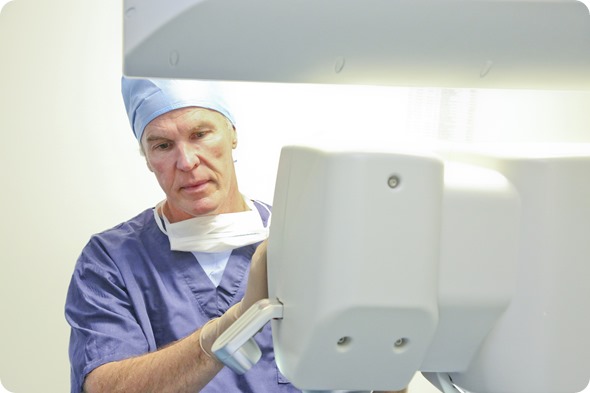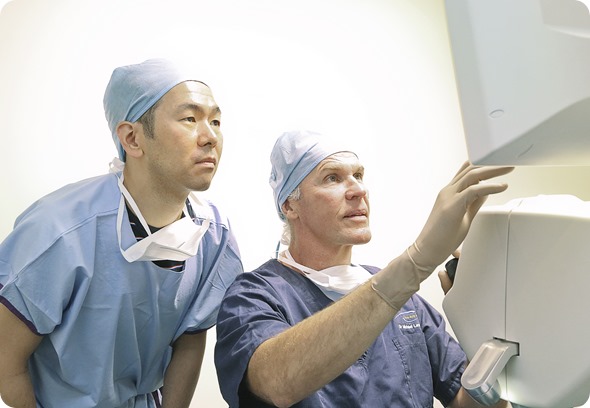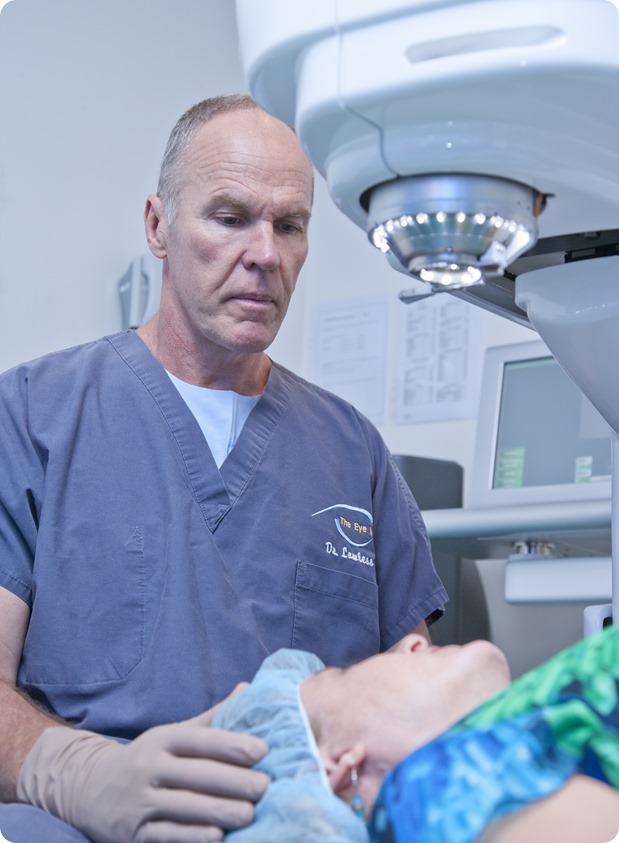Trifocal intraocular lenses (IOLs) represent the latest in premium lens technology. They are tiny, artificial lenses that are implanted into the eye during a cataract or lens replacement procedure.
Prior to trifocals, the only options available to patients were either monofocal (offer clear vision at a single distance) or multifocal (offer both near and far focus). Glasses are still often required for certain activities with these particular IOLs.
However, as their name suggests, trifocal lenses provide clear vision at three distances – near, intermediate and far – thus offering the best chance of true spectacle independence.
Patients can switch naturally between all three distances. It should be noted that trifocal lenses are actually a type of multifocal lens, in that they provide clear vision at multiple distances.

© Vision Eye Institute
Who are trifocal lenses suitable for and what benefits can they provide?
Trifocal lenses have been designed for people who want the best chance at eliminating the need for glasses altogether. However, patients must be made aware that there is no guarantee that glasses won’t be required post-operatively.
Likewise, preoperative counseling should include a discussion about the possibility of revision surgery should the resultant visual acuity not meet patient expectations.
In fact, patients may need to accept a small compromise in distance clarity. Ideal candidates are over 55 years of age, already heavily dependent on glasses (especially multifocals), long-sighted and highly motivated.
Trifocal IOLs can also correct astigmatism. People who don’t mind wearing glasses or who have unrealistic expectations may be best suited to other IOL options.
How do trifocal lenses differ from previous multifocal lenses?
The trifocal lens design includes a third focal point (intermediate distance), in addition to near and far distances, and suit a wider range of patients than the older multifocal designs. This is a real advantage when using computers and mobile devices, such as smartphones and tablets.
More so than for other IOL designs, the surgeon’s skill and experience in determining patient suitability, and with trifocal lens placement, significantly affects whether a successful outcome is achieved.
To be used effectively the patient must be anatomically suitable preoperatively, without significant ocular surface disease. The tear film has to be normal, and accurate biometry and IOL power selection is essential. Any issues that could decrease vision quality from the front, middle or back of the eye should be resolved preoperatively.
Patients really need to do their research and ask the appropriate questions before selecting a surgeon.

© Vision Eye Institute
What were the main challenges in developing trifocal lenses and what stage of design are they currently at?
Currently, the quality of the images produced by trifocal IOLs can be affected by a number of factors, including internal aberrations due to the lens shape and the specific diffractive or refractive features of the IOL.
A critical component of the design is how light entering the eye is distributed to each of the focal points. Consequently, the main challenge in designing a trifocal lens is how to optimally split the light for near-, intermediate- and long-distance focus.
With refractive IOLs, multiple zones have different optical powers and incoming light shifts direction as it passes through. The main issue with these lenses is that they are pupil dependent and the patient’s pupil size might not match the task required. For example, if the pupil constricts in highly-lit conditions, the patient tends to loses clarity at near distances.
In contrast, light is scattered in different directions to the various focal points with diffractive IOLs. Generally, these types of lenses offer a better outcome compared to refractive versions (e.g. better optical quality and contrast sensitivity, and less glare and halos). However, loss of energy is an issue with diffractive IOLs.
In Australia, we have or will have access to three different trifocal lenses – the Carl Zeiss AT LISA 839MP, FineVision micro-IOL and Alcon PanOptix IOL. It will be interesting to monitor the use of trifocal lenses in Australia, as it has remained consistently low for some time.
Interestingly, the next stage in IOL design looks to be via non-multifocal approaches.
In what ways can trifocal lenses be further improved?
Trifocal IOLs can create some issues with the patient’s vision, including contrast sensitivity and pseudophakic photic phenomena (e.g. glare and haloes). This may be acceptable for some people, especially if both eyes are healthy.
However, there are instances where this is not an option. This could be for personal comfort or for other reasons, such as occupations that require night-time driving or the ability to work in low light (e.g. taxi/cab drivers, pilots or astronomers). Many patients do adjust to the photic phenomena with time.
Blended vision, which uses monofocal IOLs to set one eye for clear distance vision and the other for intermediate or near vision, may be a more appropriate option for some people.
Are there any other downsides of current trifocal lenses?
Trifocal IOLs are also not indicated where there is co-existing eye disease (e.g. macular, retinal or corneal disease) or in patients with only one functional eye (e.g. amblyopia or lazy eye).
Aspheric monofocal IOLs with both eyes set to clear long-distance vision, supplemented by reading glasses, is the recommendation for these patients.

© Vision Eye Institute
What are the risks attached to eye surgery?
Eye surgery is just like any other surgery – there are always associated risks, which will vary between patients. Factors to be taken into consideration include the experience and skill of the surgeon, as well as the health and anatomy of the patient’s eye. It’s also important to remember that the risks must be weighed against the benefits that the surgery offers.
Luckily, cataract surgery is one of the most commonly performed surgeries in the world and complications are generally very low, regardless of whether a manual or laser technique is employed. Using a surgeon who specializes in trifocal IOLs and who uses state-of-the-art equipment will reduce the risks even further.
The main risk with trifocal IOLs versus a monofocal IOL is in the visual outcome following implantation. Patients may experience visual disturbances, particularly in light-restricted conditions (e.g. driving at night). If the desired visual acuity is not achieved, some patients may opt to replace the trifocal IOL with a traditional IOL.
Interestingly, researchers in Spain have just developed a handheld device that simulates visual outcome with monofocal, bifocal and trifocal IOLs. If this device becomes available commercially, patients can ‘test-drive’ the different lenses preoperatively – this should theoretically reduce the risk of explantation.
Other risks of cataract surgery include posterior capsule opacity, a malpositioned or dislocated IOL, eye inflammation, corneal or retinal swelling and ocular hypertension. Very rarely, severe vision loss may occur as a result of infection or intraocular hemorrhage.
Again this is highly unlikely, given the success rate for cataract surgery, but careful surgeon selection can minimize the risk. Any post-operative issue must be dealt with aggressively in order to achieve a satisfactory result.
What do you think the future holds for laser eye surgery?
Multidisciplinary and international collaboration is key to advancing technology and providing optimal patient care, and I’m excited to be involved on the frontline. This is a great time to be an ophthalmologist – I’ve seen so many ‘firsts’ over the last few years and surgical techniques are continually being refined.
In the next few years, we can expect to see light-adjustable lenses (where the power can be modified post-operatively), extended depth-of-focus lenses and the ClarVista-Harmoni lens (with a removable optic for post-operative adjustment).
However, when these become available, we still need to consider safety and effectiveness in comparison to currently available options. New does not necessarily mean better.
Where can readers find more information?
About Dr Michael Lawless MBBS FRANZCO FRACS
 Dr Lawless is Clinical Associate Professor at the Sydney Medical School, University of Sydney and an ophthalmic surgeon at Vision Eye Institute.
Dr Lawless is Clinical Associate Professor at the Sydney Medical School, University of Sydney and an ophthalmic surgeon at Vision Eye Institute.
He is a recognised world authority in eye surgery. His specialty is laser vision correction, cataract and lens surgery, and corneal transplantation. He has performed over 25,000 surgical procedures in the following areas:
- LASIK, SMILE and ASLA
- Laser cataract and lens surgery, implantable lenses
- Corneal transplantation
Education
Dr Lawless graduated in medicine from the University of Sydney in 1980. Ophthalmology training in Sydney was followed by two years of sub-specialty education, a corneal and external diseases fellowship with Professor Doug Coster in Adelaide, and a second fellowship in corneal and refractive surgery with Professor Richard Troutman at the Manhattan Eye, Ear and Throat Hospital in New York.
Career highlights
- First Australian to perform laser cataract surgery with the femtosecond laser (February 2011)
- Performed the first LASIK procedure in Sydney (1995)
- President, International Society of Refractive Surgery (2001)
- Chairman, Department of Ophthalmology, Royal North Shore Hospital (2000–2006)
- Over 100 publications in the peer-reviewed scientific literature and textbook chapters on innovations in eye surgery
- Selected to perform televised live surgery at international meetings, including the American Academy of Ophthalmology, the American Society of Cataract and Refractive Surgery and the Asia-Pacific Academy of Ophthalmology
- Keynote lecture: The future of laser cataract surgery, American Academy of Ophthalmology Chicago (November 2012)
- Convenor, Cataract Scientific Program, Asia-Pacific Academy of Ophthalmology meeting, India (January 2013)
- Consultant ophthalmologist to the Australian Defense Force
Awards
- Cedric Cohen Medal for Excellence in the Royal Australian College of Ophthalmologists examination (1982)
- Visiting Professor, University of Melbourne (1998)
- Founders Award from the International Society of Refractive Surgery, Chicago (2005)
- Invited guest lecturer to the world’s main scientific meetings, including the American Academy of Ophthalmology in New Orleans (November 2013) and the World Ophthalmology Congress in Tokyo (April 2014)
- Senior Honor Award, American Academy of Ophthalmology for Services to Education in Ophthalmic Surgery (2012)
- President’s Guest Lecturer, All India Ophthalmological Society, Kolkata (March 2016)